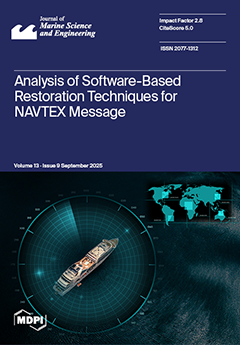Numerical simulations of an open-water propeller are performed using CFDShip-Iowa. The propeller, originally designed by Mercury Marine for a 21 feet high-speed planing hull, is scaled to match a 42 feet hull configuration. Three advance ratios (
= 0.8, 1.1, and 1.4)
[...] Read more.
Numerical simulations of an open-water propeller are performed using CFDShip-Iowa. The propeller, originally designed by Mercury Marine for a 21 feet high-speed planing hull, is scaled to match a 42 feet hull configuration. Three advance ratios (
= 0.8, 1.1, and 1.4) and two cavitation numbers (
σ = 0.274 and 1.095) are considered in the computations, and the results are compared with those obtained from the commercial CFD solver STAR-CCM+. For the fully wetted conditions without cavitation, the overall trends of the computed thrust (
), torque (
), and propeller efficiency (
) with respect to the advance ratios are similar. The computed
,
, and
with cavitations generally agree with the STAR-CCM+ results except for
at
= 0.274, where the latter shows a much higher value for
J = 1.4. For
= 1.095, the cavitation patterns and overall pressure distributions are similar for both codes. For
= 0.274, the cavitation is more violent for CFDShip-Iowa than STAR-CCM+. CFDShip-Iowa shows better preservation of the cavities and blade-to-blade interactions, which are not captured in the simulations using STAR-CCM+, since a single blade with periodic boundary conditions are used.
Full article





